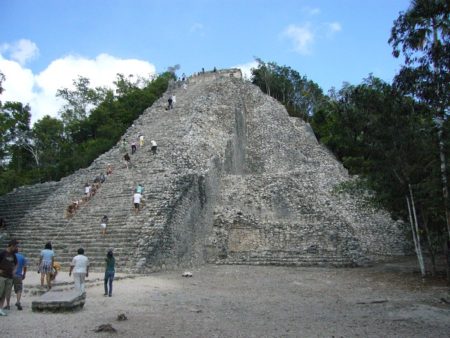Mérida, Yucatán, (June 17, 2021).- In the framework of the construction of the Maya Train, the federal government will allocate 849 million pesos (42 million USD), for research work in archaeological zones of Campeche, Chiapas, Quintana Roo, and Yucatán, revealed the Secretary of Culture of the Government of Mexico, Alejandra Frausto Guerrero.
She indicated that both the agency under her charge and the National Institute of Anthropology and History (INAH) will make important investments destined to the existing and the uncovered archaeological zones that are distributed along the route of this railway project.
Only for the pre-Hispanic sites of Yucatan 381 million pesos will be allocated; for Chiapas, the amount is 206 million pesos; as well as 160 million pesos for Campeche and 102 million for Quintana Roo.
She stated that these actions “essentially integrate a cultural project that seeks to demonstrate the vitality of the Maya culture. For this reason, the services will be dignified and the architectural complexes of various archaeological zones distributed along this route will be improved through a historical investment ”.
In line with the work axes of the Ministry of Culture, the work that will be carried out in several archaeological zones in the Yucatan Peninsula seeks to dignify cultural heritage, expand research and conservation of cultural assets, guarantee their protection, improve services for visitors and, of course, promote the development of the local Maya indigenous communities.
The actions will revitalize the archaeological zones of Palenque, Edzná, Ruta Puuc, Chichén Itzá, Tulum, Cobá and Calakmul, which “are an example of the Maya culture due to their heritage value, to benefit the communities and redistribute the flow of tourists, which will allow boosting the economic development of the area”.
Among others, the renovation of facilities, museum rooms, and service areas, updating of management plans, creation of new museum enclosures, the opening of spaces currently unexplored by the public, in addition to expanding visiting hours to diversify experiences in the observation of astronomical phenomena, biodiversity and the implementation of elements for universal accessibility, to name a few.
Thus, the Puuc Route will receive 116 million pesos, for improvement works in Uxmal, Kabah, Xlapak, Sayil, Oxkintok, Chacmultún and Labná.

“Thanks to this, the route through Uxmal will grow with the incorporation of architectural complexes that were not accessible to the general public and with the rehabilitation of the sacbé or main road that connects it with Kabah, it is about 18 kilometers that will now be visited and in which raises the integration of nearby communities, ” she said.
Likewise, with these resources, research, conservation, and consolidation in various palaces, pyramids, and temples that make up the route are foreseen; a Site Museum will be built in Kabah; and the conservation of structures, the improvement of trails, and the rehabilitation of service areas for visitors in most areas will be addressed.
While for Chichén Itzá 265 million pesos are allocated, which will be channeled to the research, conservation and maintenance of 23 buildings and the construction of its Site Museum, “a debt owed to visitors to facilitate understanding of the becoming of this ancient Maya city ”.
Similarly, the expansion of the visiting area stands out, integrating the so-called Initial Series, in Chichén Viejo.
In the case of Palenque, Chiapas, 206 million pesos will be allocated for the conservation and restoration of 23 monuments and the extension of the route to new archaeological exploration areas.

With these resources it will also be possible to regularize the estates of the polygonal area of the archaeological zone, inscribed on the Unesco World Heritage List; reorder informal commerce, in addition to rehabilitating the Site Museum and the construction of laboratories.
In Tulum, Quintana Roo, 65 million pesos will be invested, to carry out conservation and maintenance tasks in the 22 buildings enabled for the visit, as well as the exploration, habilitation, and public opening of monuments in Tancah, to expand the visiting area.
Therefore, with these resources, an immersive room will also be built in Tulum and the Tulum-Tancah connection path will be enabled, among other actions that will allow tourists to have a better experience on their visit.
In Cobá, with the exercise of 37 million pesos, conservation and maintenance will be undertaken in the sets of monuments called Macanxoc, Cobá, Nohoch Mul, and Chumuc Mul; in addition, the reconfiguration and improvement of services to the public will be carried out.

While in Campeche, other major archaeological zones that will receive financial support are: Calakmul, a mixed World Heritage site, where the buildings that make up the Chiik Naab Complex will be consolidated and stabilized, some of which retain mural paintings, and maintenance will be provided to 27 archaeological structures.
Additionally, in conjunction with the Ministry of Communications and Transportation, the improvement of the access road is projected, works for which an investment of 80 million pesos is contemplated.
Likewise, in Calakmul, museography spaces of the Site Museum will also be rehabilitated and work will be carried out to improve the hydraulic, electrical, and wastewater treatment facilities.

An equal amount will be invested in Edzná, also in Campeche, to consolidate, conserve, study and restore the Building of the Five Floors, the South Temple, the Small and the Great Acropolis, the Platform of the Knives and the Patio de Los Embajadores complex. .
In addition to maintaining the Nohochná buildings, the Baths and the hieroglyphic staircase, and remodeling the Stela Interpretation Center.
Regarding the improvement of its infrastructure, a module will be built for the management of cultural assets, which will include a laboratory for the analysis of archaeological materials; as well as the comprehensive rehabilitation of visitor services.
These tasks will be carried out with the endorsement of the Council of Archeology and with the supervision of the INAH specialists, an entity that, in accordance with the provisions of the Federal Law on Monuments and Archaeological, Artistic and Historical Zones, has the responsibility to protect, investigate, conserve and disseminate the archaeological and paleontological heritage of Mexico.



